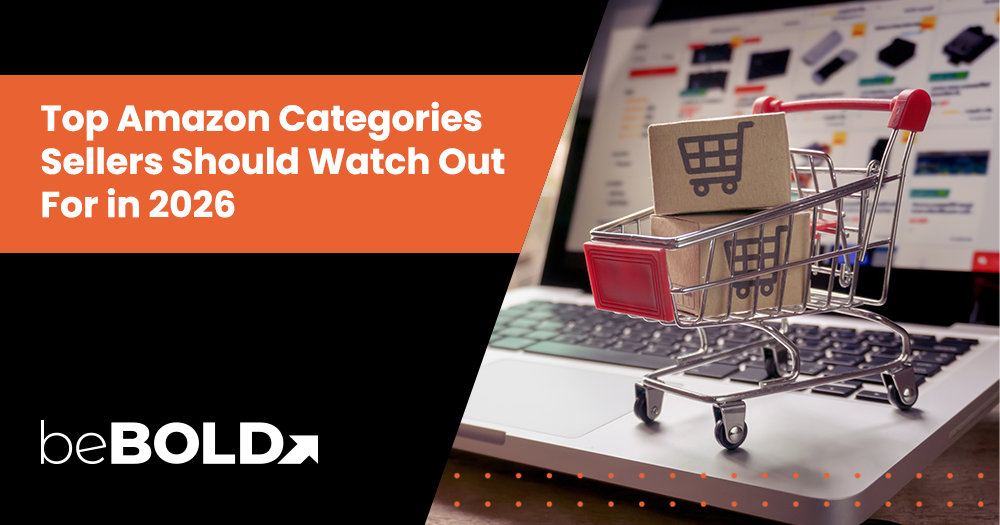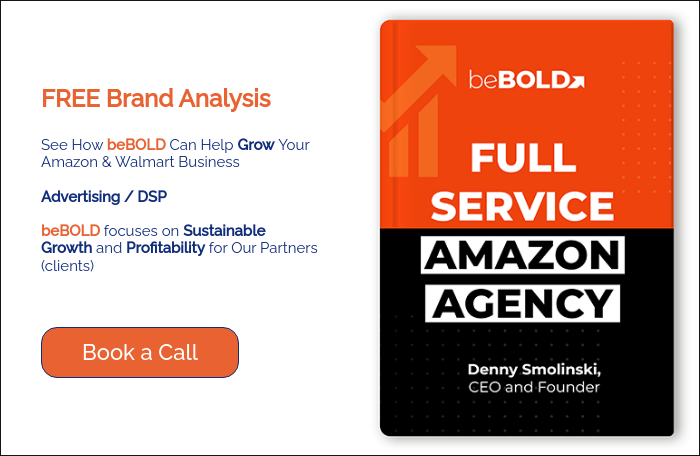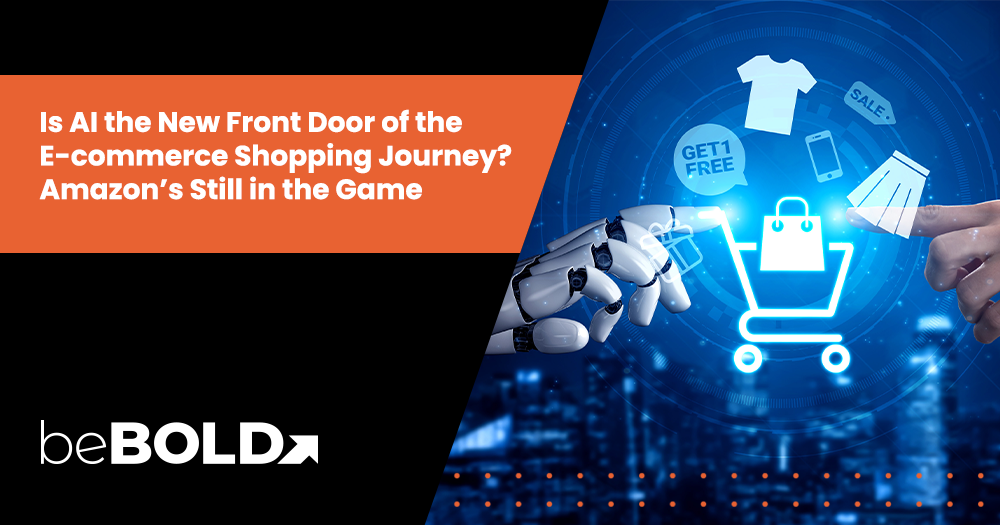As we head into 2026, the categories that win on Amazon share three traits: large addressable demand, repeat-purchase behavior, and strong discovery across search and social media. To help Amazon sellers prepare for the coming year, we at beBOLD Digital have created a forward-looking guide to help you prioritize where to build, launch, and scale next.
Key Summary
- Beauty & Personal Care; Health & Household; Home & Kitchen; Electronics Accessories; Toys & Games; Pet Supplies continue to dominate by volume—and will remain reliable hunting grounds for well-differentiated offers in 2026.
- Repeat-consumption categories (beauty, health, pet, baby) are best for Subscribe & Save, bundling, and LTV growth—critical in a higher-CPC landscape.
- Accessory-led tech (chargers, surge protectors, small electronics) offers healthier margins than flagship hardware if you build compatibility SEO and trust signals.
- Design-forward Home & Kitchen and Smart Home add-ons will keep benefiting from social commerce and gift-driven shopping spikes.
- Competition is real. Home & Kitchen and Beauty are among the most crowded; you’ll win by niching deeper, improving PDP content, and timing launches around seasonality.
10 Amazon Categories to Keep an Eye Out
Forecasted Popular Amazon Categories in 2026
|
Rank |
Category |
Products to Consider |
|
1 |
Eco-Friendly and Sustainable Products |
Refillable products, such as serums, cleansers and pet shampoos |
|
2 |
Health and Wellness |
First-aid basics, health supplements |
|
3 |
Home Office and Remote Work Accessories |
Organizers, desk lamps |
|
4 |
Smart Home Devices and Accessories |
Smart curtains and blinds, smart device batteries |
|
5 |
Pet Products |
Dog chews, pet food toppers |
|
6 |
Tech and Gadgets |
Fast chargers, charging cables |
|
7 |
Beauty and Personal Care |
Skin care products with active ingredients |
|
8 |
Baby and Child Products |
Cotton baby clothes, carriers |
|
9 |
Home Improvement and DIY |
Rent-friendly shelves, wallpapers |
|
10 |
Outdoor and Adventure Gear |
Vacuum flasks, collapsible chairs and tables |
To turn this 2025 snapshot into 2026 action, lean into evergreen demand while carving out defensible micro-niches and stronger post-purchase economics. Here’s how that looks category by category.
Eco‑Friendly and Sustainable Products

Source: Amazon
Shoppers still watch their budgets, but when you show that a product wastes less, lasts longer, or is easier to reuse, they listen. Think of sustainability as a value boost you layer onto Beauty, Home, Baby, and Pet, and not a separate niche. In fact, studies have shown that products labeled as sustainable generally sell better. Products with a sustainability label saw a 13% increase in demand, regardless of pricing and coupon availability.
In plain terms: if it’s sustainable, refillable, repairable, or clearly more durable, it has a better shot in 2026. Your job is to make that advantage obvious in the first three images and the first two bullets.
beBOLD Tip: If you want deeper context on what drives demand spikes and shifting buying habits, our Psychology of Black Friday: Consumer Behavior, Statistics & Trends offers useful behavioral insights.
Product Types You Should Look At
- Refill systems (serums, cleaners, pet shampoos), simple replacement parts (gaskets, filters), and tougher materials (rust‑proof steel, bamboo blends, PCR plastics).
- Smaller, right‑sized packaging that ships well.
What beBOLD Digital Recommends
- Add a quick “Why it’s greener” callout up top (less plastic, longer life, fewer refills).
- Target intent terms like refill, reusable, recyclable, fragrance‑free, plastic‑free.
- Show a simple lifecycle visual and a one‑glance comparison vs. the non‑sustainable option.
- Perform A/B testing on creatives to boost click-through and conversion.
Health and Wellness

Source: Amazon
Health & Household wins on routines. If the product fits into a daily or weekly habit, you get repeat orders. What works best right now is straightforward: compliant copy, obvious dosing, and a routine buyers can follow. Then, lock in LTV with Subscribe & Save and smart multipacks.
Product Types You Should Look At
- “Free‑from” formulas (dye‑free, fragrance‑free), sensitive‑skin SKUs, travel sizes, and family‑size multipacks.
- Everyday topicals (creams, patches), oral care, first‑aid basics, and sleep/support accessories (with non‑medical claims).
What beBOLD Digital Recommends
- Go after need‑state keywords (e.g., “for sensitive skin”). Use SBV to demo routines in under 20 seconds. Re‑engage lapsed S&S customers with DSP.
- Shift to products that are organic and have certifications for sustainability as we have seen a growing trend of parents shifting to more sustainable options.
Home Office and Remote Work Accessories

Source: Amazon
Hybrid isn’t going away. Small, tool‑free upgrades that make tight spaces feel calmer and more productive still sell. Lean into ergonomics, cable control, lighting, and call quality. Keep products compact, quick to install, and easy to visualize in a small apartment or shared desk.
Product Types You Should Look At
- Fold‑flat laptop stands, wrist rests, under‑desk trays, clamp‑on lights, compact mics.
What beBOLD Digital Recommends
- Lead with before and after desk shots and clear dimensions for small workspaces.
- Keywords to cover: tool‑free, fold‑flat, adjustable height, cable management.
Smart Home Devices and Accessories

Source: Amazon
Households keep adding devices, but the best margins are in accessories, especially when you own compatibility search. Skip the costly hub battle. Win on mounts, power, sensors, and parts designed for specific models.
Product Types You Should Look At
- Low‑profile mounts, cable covers, replacement batteries, privacy shutters, weatherproof housings.
What beBOLD Digital Recommends
- Add a big, scannable compatibility table (brand → model → year), quick install steps, and a QR to the how‑to video.
- Keywords to cover: for [device/model], Matter/Thread ready, no‑drill, renter‑safe.
Pet Products

Source: Amazon
Pet spend stays resilient because pets are family. Build for consumables and problem‑solvers, tie benefits to outcomes, make feeding or sizing dead simple, and use Subscribe & Save to turn one‑time buyers into regulars.
Product Types You Should Look At
- Dental chews, hip & joint toppers, calming treats, enrichment feeders, travel water solutions.
What beBOLD Digital Recommends
- Add feeding charts by weight/age and durability notes (e.g., chew tests).
- Avoid disease claims.
- Add information for pet products based on cat or dog breeds.
If you're expanding into consumables like treats or toppers, make sure you understand category rules and compliance—our guide on How to Sell Grocery on Amazon Successfully walks you through the essentials.
Tech and Gadgets

Source: Amazon
Accessories refresh often, ship light, and rank on long‑tail keywords, which is great for margins if your listing screams “safe and compatible.”
Go where the refresh cycle is constant: chargers, cables, and power strips. Prove safety and compatibility in the images so buyers don’t second‑guess.
Product Types You Should Look At
- 65W/100W USB‑C chargers, braided cables in common lengths, multi‑port power strips.
What beBOLD Digital Recommends
- Show a wattage/compatibility matrix, safety testing where applicable, length comparisons, and simple heat‑management visuals.
Beauty and Personal Care

Source: Amazon
Beauty still rides social waves, but long‑term wins come from proof and easy replenishment. Our beBOLD Digital experts note that most buyers of beauty products on Amazon focus heavily on trustworthiness, with most buyers choosing to order from brand storefronts and authorized sellers.
Once you get the first win in the Beauty and Personal Care category, keep momentum with Subscribe & Save, travel sizes, and shade/size extensions.
Product Types You Should Look At
- Sensitive‑skin actives, multi‑benefit serums, heatless hair tools, refillable body care.
What beBOLD Digital Recommends
- List INCI ingredients, mention patch testing, and map the routine.
- Shift to a clinical‑style design for your visuals, but only when supported.
Baby and Child Products

Source: Amazon
The US baby products industry represents around $6.4 billion in sales every year, making parents one of the best segment to target when looking to start out as a seller. Parents buy products that feel safe and simple for their children. When sellers offer certifications, quality assurance, and accurate safety notes, they can easily earn trust and get repeat orders.
Make life easier: ship pre‑assembled when you can, show everything in the box, and highlight safety credentials without jargon.
Product Types You Should Look At
- Tool‑free organizers, bath‑time kits, travel‑friendly gear, soft‑touch materials.
What beBOLD Digital Recommends
- Clear age ranges and safety notes; add choking‑hazard warnings where needed.
- Shift to products that are organic and have certifications for sustainability as we have seen a growing trend of parents shifting to more sustainable options.
Home Improvement and DIY

Source: Amazon
The DIY market has been seeing a steady increase since the pandemic, with the industry seeing a 2.3% increase from 2023 to 2025. Today, homeowners and renters choose to renovate and improve their homes on their own instead of hiring a handyman.
But what do they usually look for? Renters and busy homeowners want household products that work fast and don’t damage walls. Keep it no‑drill, quick‑install, and space‑saving. Show the transformation in a single before/after image and add a QR to a 30‑second tutorial.
Product Types You Should Look At
- No‑drill storage, cable raceways, adjustable shelf risers, door/closet organizers.
What beBOLD Digital Recommends
- Spell out surface compatibility (tile, painted drywall), load ratings, and exactly what hardware is included.
Outdoor and Adventure Gear

Source: Amazon
Weekends are the use case. Lightweight, packable gear that makes a quick trip easier tends to convert—especially as gifts.
Bundle thoughtfully (starter sets) and schedule coupons ahead of spring/summer and Q4. Offer good/better/best versions so shoppers can level up.
Product Types You Should Look At
- Collapsible bottles, ultralight chairs, ripstop blankets, paddle/ball kits.
What beBOLD Digital Recommends
- Show weight and capacity, the packed size, and simple care notes. If it fits in a backpack pocket, show it.
Macro Trends and Factors That Can Influence Product Performance in 2026
Before you green‑light any product in 2026, zoom out. Three macro forces, trust, sustainability, and shifting generational purchasing, are shaping what converts, what gets repeat orders, and what scales on PPC/DSP. Use the playbook below to pressure‑test new ideas and upgrade existing listings.
Trust as a Business Driver
Trust isn’t a tagline; it’s a conversion lever you can design into the PDP. In crowded listings, trust signals, such as warranty length, verified testing, transparent materials, and responsive customer service, correlate with conversion and review velocity. Bake them into your images to win the scroll.
What Should You Implement Now?
- Place your top three trust cues in images 1 to 3: Include your warranty badge, testing and certification callouts (safety and compliance), and material transparency (BPA‑free, rust‑proof, hypoallergenic, etc.).
- Show proof: Add a mini comparison chart vs. your competitors, add close‑ups of build quality, and a “what’s in the box” visual to reduce return‑driving surprises.
- Operationalize service: Stick to a 24‑hour response target, clear replacement/refund policy in the PDP Q&A, and add a QR code to support (not to reviews) in packaging.
beBOLD Tip: Want faster inbound processing and fewer compliance delays? Understand the rules inside the Amazon Dangerous Goods Program.
Sustainability as a Trust Builder
“Refill, repair, recycle” messaging helps justify price premiums and increases Subscribe & Save opt-ins across Beauty, Health, and Home. Treat it as a conversion lever, not just a brand statement. And because conversion strength also influences how Amazon rewards listings in search, it’s worth understanding how these signals tie into platform recognition. For a deeper look at how Amazon evaluates strong performers, check out “Amazon’s Choice Badge Explained: What It Means & How to Get It.”
What Should You Implement Now?
- Quantify impact in bullets: Add product descriptions like, “One refill replaces ~4 plastic bottles,” “Designed for 100+ uses,” or “Ships in recyclable mailer.”
- Back claims with evidence: Add links to test reports/certifications, or add evidence to images or A+ content where allowed. Avoid vague “eco‑friendly” phrasing.
- Optimize packaging for FBA: Use the right‑size boxes to avoid DIM weight.
Generational Shifts in Purchasing Power
Different generations shop differently: Gen Z discovery via TikTok keeps feeding demand in Beauty and Small Home Gadgets, while Millennials continue to anchor Pet, Baby, and Home spend. Gen X values durability and ease‑of‑use.
While most of the market have adjusted their strategies to millennials’ choices due to their spending power (approximately $2.5 trillion in 2024), knowing how to target Gen Zs and Gen Xs have their own benefits, especially as both of these generations also have high influential market power. Using generational differences, sellers can easily calibrate their creatives to better reach their intended buyers.
What Should You Implement Now?
- Gen Z (value + authenticity): Use short UGC video, trend‑aligned hooks, installment‑friendly price points, and bold before/after visuals.
- Millennials (family + convenience): Create multipacks and Subscribe & Save bundles, time‑saving benefits, and durability guarantees, such as pet-friendly or child-friendly.
- Gen X (quality + clarity): Add compatibility tables, “install in 5 minutes” imagery, and accessible support and contact info.
How beBOLD Digital Recommends Finding and Marketing Lower‑Competition Products
Finding “white space” inside crowded categories is where we live. Below is the 5‑step playbook we use for Amazon (and Walmart) brands, especially in Beauty, Home, Pet, and Tech Accessories, to uncover lower‑competition products with real margin and repeatability.
- Start with the buyer, not the product. Map areas for improvement from reviews/Q&A of the top 100 ASINs. Identify persistent complaints, and then cluster by use case, such as fragrance-free, travel-friendly, or renter-safe. This will create a customer‑problem log that you can solve with design, bundle, or format changes.
- Validate stability over hype. Check 90- to 180‑day price stability and rank consistency, favoring year‑round use over fads. If the top ASINs are discount‑dependent or show review cliffs, it would be better to pass up on that product.
- Design the moat before placing the product order. Outline how the SKU will win the listing, such as main‑image angle, comparison chart, compatibility table, routine‑builder, and an upsell/bundle that raises AOV on day one.
- Model unit economics + LTV early. Pressure‑test landed cost vs. FBA, expected CPC, and contribution margin at realistic promo levels. For replenishable categories (Beauty, Health, Pet), add Subscribe & Save and a 2‑pack/multipack to forecast LTV.
- Pilot fast, learn faster. Run a 90‑day launch calendar. Run creative A/B testing on the main image or video, adjust long‑tail keyword focus, and create a tight PPC structure. If applicable, add TikTok UGCs to add additional social proof.
Find the Best Category for You This 2026
The top categories don’t automatically equal the best for you. In 2026, the winners will go narrower, signal trust earlier, and design for LTV (bundles, refills, subscriptions). If you’re eyeing Beauty, Home, Pet, or Tech Accessories in 2026, we’ll help you validate sub‑niches, architect PDPs, and launch with LTV in mind, then scale with PPC/DSP that matches each category’s seasonality and margin profile. Let’s shortlist 3 to 5 niches and build your 90‑day test plan - Contact us today!
Frequently Asked Questions
Are Amazon’s top‑selling categories the same every year?
Not exactly. The parents (Home & Kitchen, Beauty, Electronics Accessories) stay consistent, but sub‑niches rotate as trends and tech cycles evolve. Use 2025 data as a baseline, then validate 2026 micro‑trends before launch.
Which Amazon categories usually see the highest seasonal spikes?
Toys & Games (Q4), Beauty (deal events + gifting), and Outdoor (spring/summer) are reliable seasonal lifts; plan inventory and promos 4–8 weeks ahead.
Do Amazon’s top categories have higher competition for sellers?
Yes. Home & Kitchen and Beauty are among the most saturated; offset with deeper niching, better PDPs, and targeted ads around long‑tail search.
Can selling in a niche subcategory be more profitable than a top‑level category?
Often, yes. Accessories and specific‑use solutions can deliver better margins and cheaper clicks than broad hero SKUs—especially in Electronics and Home.
How do global markets impact Amazon’s top categories?
Local seasonality, device ecosystems, and fulfillment costs shift winners by marketplace; still, Beauty, Home, and Electronics Accessories travel well due to universal needs. Validate per‑market compatibility and compliance.
Are top Amazon categories always the most profitable for new sellers?
No. “Popular” ≠ “profitable.” Profit depends on landed cost, CPC, review moat, and differentiation. Many sellers find better ROI in micro‑niches inside popular parents.
Do top Amazon categories influence search rankings on the platform?
Not directly. Category choice shapes competition level and relevance signals, which affect how quickly you can rank. The real levers are keyword relevance, conversion, reviews, and price stability.










Comments